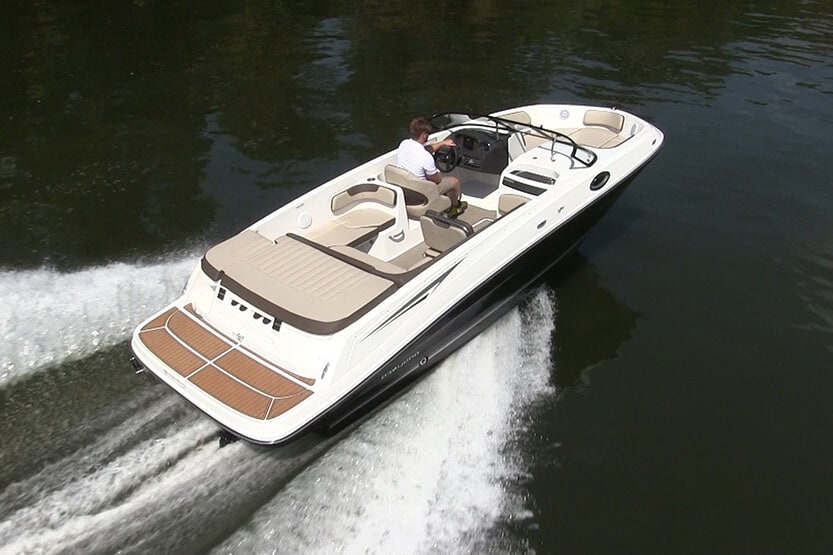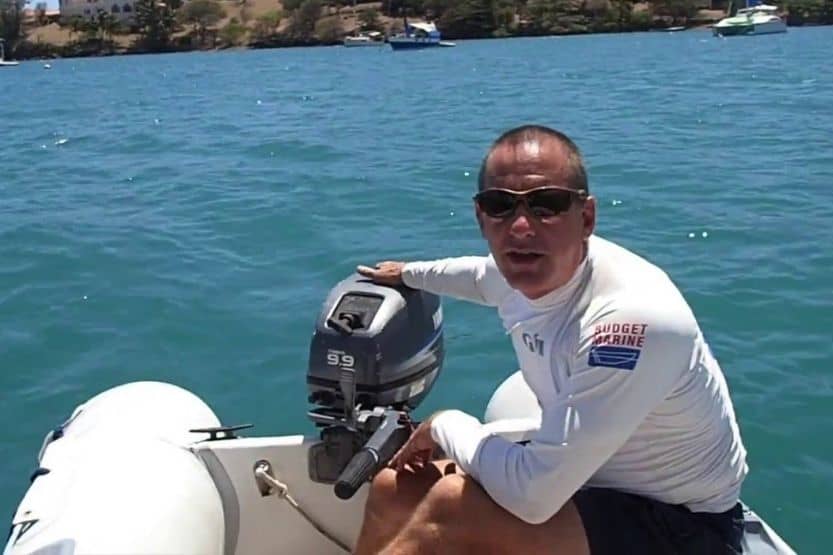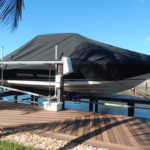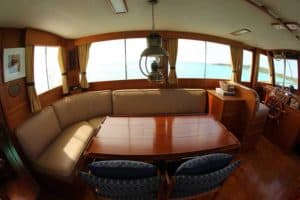Many boat engines have motors that can achieve 4,800 to 6,000 revolutions per minute at full throttle. A common issue some experience is that their boat can only reach 3,000 rpm under load. What if your boat won’t go over 3,000 rpm under load?
If your boat is not able to go over 3,000 rpm under load, it could mean that there is a damaged part. A boat component or one of its systems could be malfunctioning and prevent the motor from exceeding 3,000 rpm.
The inability to produce the required revolutions per minute is one of the most common engine problems. The primary cause is the lack of regular maintenance.
For possible solutions, you might need to replace the ignition sensor or electric fuel pump. Also, check the fuel pressure and the spark plugs in case they need to be replaced.
In this article, we’ll look at these 10 common causes for a boat not being able to go over 3,000 rpm under load:
- Wrong kind of fuel
- Wrong propeller
- Presence of dirt and debris
- Dirty or malfunctioning carburetor
- Failing ignition system
- Damaged propeller assembly
- Poor cylinder compression
- Overheating engine
- Overloading the boat
- Failing neutral safety switch

Read on to learn more about why your boat won’t go over 3,000 rpm under load and how to fix this problem.
Boat Won’t Go Over 3000 RPM Under Load
A boat that won’t go over 3,000 rpm has a malfunctioning or damaged part. To fix the problem, the boat’s engine and parts must be inspected. Any faulty or damaged parts must then be replaced.
There is not just one reason why a boat will not be able to go more than 3,000 rpm under load. Most boat engines have motors that can achieve at least double this speed at full throttle.
See below for 10 possible causes of a boat not being able to go over 3,000 RPM.
1. Wrong Kind of Fuel
Are you sure you’re using the right kind of fuel that is required by your engine? Gasoline used for boats contains 10% ethanol to oxygenate the gasoline and burn it more efficiently.
So your engine will produce lower emissions and better efficiency. This has a huge effect on your boat’s engine power.
However, the presence of ethanol in the fuel causes old fuel to go stale. There might be some presence of water in the fuel since ethanol attracts moisture. When moisture is present in the fuel, its combustion ability will be adversely affected.
Moisture in the fuel will also encourage microbial growth inside the fuel tank. The presence of moisture will encourage the development of rusts as well. That means there is a possibility that your fuel tank will get rusty over time.
Ethanol also gets stale. When it becomes stale, it is less volatile, meaning it is more difficult to burn. A surefire way to resolve this dilemma is to drain the old fuel from the fuel tank.
Then clean the tank if you can and then refill it with new fuel. That should restore the ability of your motor to generate more than 3,000 rpm.
Another solution to this issue is to inspect the condition of your fuel tank. If there is rust, mold, or gunk in the tank, try to clean or remove the dirt. If you can’t, you have to replace the tank altogether.
After replacing the tank, maintain its cleanness so you won’t have to replace it again. To prevent moisture from contaminating the tank, always keep it full. It will prevent air with moisture from damaging your tank.
2. Wrong Propeller
Another probable reason your boat doesn’t go over 3000 rpm under load is that it has the wrong propeller.
The right propeller size should be used in a boat. If it’s the wrong propeller size, the engine’s rpm will be affected. There is a relation between the propeller size and the rpm of the engine of the boat.
- For every inch added in the diameter of the propeller, there will be a reduction of about 500 revolutions per minute.
- For every inch of blade pitch added, there will be a reduction of around 150 to 200 rpm.
In view of this, if your propeller is too big or its pitch is too high, your engine rpm will fall below 3,000 rpm. Considering that most boat engines can deliver 6,000 rpm, you have to use a propeller that is grossly wrong in size to reduce your engine’s rpm.
3. Presence of Dirt and Debris
If there are too many algae growth and barnacles on your boat, they can add up to the load being carried by your engine as you propel your boat forward on the water.
Algae and barnacles can grow on your propeller shaft, propeller, the bottom parts of the boat, and so forth. Anything that interferes with your propeller’s operation will reduce your engine’s rpm.
It is imperative that you follow a cleaning schedule for all your boat parts, inside and out. The engine’s carburetor must also be kept clean always to ensure it is always functioning properly so that your engine can fire efficiently.
4. Dirty or Malfunctioning Carburetor
The next possible cause for why a boat won’t go over 3000 rpm under load is a dirty carburetor.

If the engine’s carburetor is working efficiently, it will mix the right amount of air intake to the right amount of fuel introduced into the combustion chambers or engine cylinders. If not, it will negatively affect the performance of your engine.
Some of the signs of a malfunctioning or damaged carburetor are the following:
- Poor idling
- Misfiring cylinders
- Slow engine start
- There is no fuel when you remove the drain screw from the carburetor bottom.
- The slow transition from idle to mid-range rpm
To correct the problem, you will need to do the following:
- Disassemble the carburetor and clean it.
- If you discover it is defective or damaged while cleaning the carburetor, get a new one to replace it.
- The easiest way is to use a carburetor cleaner to clean it. There are cleaners specially designed for carburetors. Just follow the instructions on the can on how to use it.
5. Failing Ignition System
If the engine’s ignition system is failing, this could also reduce its rpm. You can determine if this is the issue if you will use a spark tester. However, testing the ignition system is not really a job that a novice can safely perform.
So if you are not a mechanic, be careful in doing this. Better yet, ask a qualified mechanic to do it. But it is also wise to know how a mechanic performs this kind of test so that you know what’s being done. The typical method of checking the ignition system is as follows:
- Remove the coil wire.
- Place the spark tester at the center of the coil wire.
- Connect the spark tester to the ground of the engine.
- Turn on the engine ignition. You should see a spark if there is nothing wrong with the system. If there are no sparks, one or more of the spark, plugs are defective. Replace the defective ones to correct the problem.
6. Damaged Propeller Assembly
A damaged propeller assembly will considerably affect the performance of the engine. Thankfully, you can easily detect and repair this problem. The common way of troubleshooting propeller issues are as follows:
- Get the boat on land and examine its propeller, particularly its blades. The blades should have no cracks, chips, dents, bends, or any damage.
Check the blades carefully to determine their actual conditions. Measure each one and see if they are still all of the same sizes. Any discrepancy in their dimensions means that some of them have sustained damage. You have to replace the propeller if its blades differ in size.
- Examine the propeller shaft. Check if it is still straight or is already bent. A bent shaft vibrates unnecessarily and will not enable the engine to reach its maximum rpm. By looking at the propeller assembly side, you will be able to see if the shaft is bent or not.
- Check the hubs to see if there are damages. Over time, hubs wear out. If your boat is more than twenty years old, this could probably the cause of the problem.
If you see any of these issues in the propeller, it is wiser to replace it with a new one instead of repairing it. Repairing a bent shaft or bent blade is difficult. It is hard to put them back in their original shape accurately.
Again, if your boat won’t go over 3,000 rpm under load, this is an indication that it needs to be properly maintained or it has a damaged part that needs to be repaired.
To further give you an idea of the parts you should check when this happens to your boat, read on!
7. Poor Cylinder Compression
The next possible cause for why a boat won’t go over 3000 rpm under load is poor cylinder compression. There could be leaks in the cylinder valves or cylinder rings.

If the engine is already old, perhaps its cylinders themselves are already worn out. Whatever the reason is, the fact is that your engine is unable to deliver the required rpm.
In the presence of any of these problems, the required pressure will not be developed inside the cylinders, which will prevent them from efficiently compressing the fuel to produce the required energy.
To determine the real issue, you have to perform a compression check on the engine. This job entails the skills and knowledge of a professional engine technician.
There are tools required to do the examination, and the procedure could be dangerous to people who do not know what they are doing.
But you can learn the concepts. The compression should be around 90 pounds per square inch (psi) for modern two-stroke outboard engines.
If the engine cannot produce this amount of compression, its cylinder chambers, rings, and valves should be checked. If they are not of the dimensions that are required, they should be repaired or replaced.
Other examinations should be performed as well. If there are differences in the compression readings with over 10 psi, the rings or the valves can be defective. Moreover, if the readings are low or inconsistent, you need to have a mechanic to examine the cylinders.
8. Overheating Engine
If your engine is always overheating, this condition will prevent it from going over 3,000 rpm. However, there are so many causes of engine overheating that it is somewhat difficult to pinpoint the problem’s cause. Some of the typical causes of engine overheating are the following:
- Faulty spark plugs
- Aerated or low engine oil
- Damaged impeller, risers, or manifolds
- Failing thermostat
- Damaged or broken water pump
- Too little engine oil circulating
If you are not familiar with these terms or issues, the best way is to bring your boat to a boat mechanic and determine the problem. If you have adequate knowledge and skills, you can do the checking yourself.
Very little oil circulating in the engine can also cause overheating. Some put too much oil, thinking that it will be good for the engine. That is not right because too much engine oil circulating in the engine is also bad. This can cause aeration and will cause engine performance to decline.
9. Overloading the Boat
You shouldn’t overload your boat. Yet, boaters expect their engines to perform as usual even if there is too much weight being carried by their boats. Overloading a boat will surely reduce its ability to produce the required engine rpm.
Aside from too many people, perhaps your boat is also carrying too many gears. All these things will impact the engine’s performance and efficiency. Try reducing the load on your boat and see if this improves its ability to produce the required engine rpm.
10. Failing Neutral Safety Switch
A malfunctioning neutral safety switch could also cause the inability of the engine to reach 3,000 rpm. While this is not a common problem, it could still be the cause of your problem. This switch is typically located inside the motor of the engine. The exact spot depends on the engine model.
If you disconnect this switch, the problem will be solved. To fully remedy the problem, you need to ask a mechanic to replace this switch with a new one. This is a handy safety feature that you should not ignore.
Conclusion: Boat Won’t Go Over 3000 RPM Under Load
If your boat won’t go over 3,000 rpm under load, it could mean that you have not maintained it properly. It may also be caused by a malfunctioning system or component of the boat.
A damaged part could also cause the inability of the motor to produce the required rpm.
There are plenty of reasons why a boat experiences this problem. You need to know what boat parts and systems can cause this problem and then examine them to assess and correct the problem.
10 common causes for a boat not being able to go over 3000 rpm under load are as follows:
- Wrong kind of fuel
- Wrong propeller
- Presence of dirt and debris
- Dirty or malfunctioning carburetor
- Failing ignition system
- Damaged propeller assembly
- Poor cylinder compression
- Overheating engine
- Overloading the boat
- Failing neutral safety switch
Related reading:
Impeller Vs Propeller [What Is the Difference Between Them?]






![Boat Floor Replacement Plywood [Best Options] boat floor replacement plywood](https://boatinggeeks.com/wp-content/uploads/2021/07/boat-floor-replacement-plywood-150x150.jpg)


![Read more about the article Spot-Lock Trolling Motor [What Is It? and Best Spot-Lock Motors]](https://boatinggeeks.com/wp-content/uploads/2021/06/spot-lock-trolling-motor-300x200.jpg)